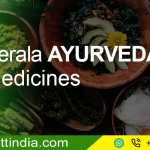The nature of Monsoon Season
In monsoon season the breeze begins from the ocean. Green plants grow everywhere. Rainy clouds pervade the sky. The water reservoirs overflow. The monotonous sound of ocean clouds, frogs and peacock sounds peculiarly. Rainbows, millipedes and lightning are very often seen. The algae and green grass appear everywhere mainly in kutaja (Holarrhena antidysenterica) flowers are seen in bushes.
The state of Agni and Dosha in Monsoon Season
The downpour and cooling of an environment after a harsh summer could make less balance in the rainy season. The nature of the season is cold and dry.
Vata can be naturally predominant in this season. When vata gets aggravated, the Pitta accumulates & Kapha has not much interference in this season. Agni also weakens. You should have easy digesting foods.
The disturbance in Agni is prominent so the strength gets less, digestives and carminatives must be taken. The regimens can be focused to balance all humors and aiding digestion. Monsoon Ayurveda Treatments keep up with the state of Dosha & Agni during this season.
The Diets to Follow During Kerala Monsoon
Oily, salty, sweet, sour and hot foods are usually advised. Old rice, jowar, wheat, the food prepared of old grains, meat soup and soup of pulses that are processed with spices or carminatives can be taken.
Fermented liquids (arishta), non-harmful wines, mardwika(dried red grapes) wines can be taken. When the water gets polluted you must drink only pure water. Drinking boiled water (in small quantities as agni may get reduced), soups and old honey are mainly recommended.
Madhura(sweet), kledayukta(oily), vata reducing, dried, light, snigdha(unctuous), ushna(hot), amla(sour), lavana(salt) tastes can be incorporated on rainy or windy days.
On heavy rain days, you have to intake easily digestible, dry foods (dry ginger), honey mixed with sour, salty, fatty and drinks, diets are also beneficial.
Bitter, spicy, astringent food can be avoided. Karkkidaka kanji has a special recipe for the rainy season. This can be a healthy tonic to boost energy, stamina & immunity. You can check out Ayurvedic Nutrition & Cookery Courses to make a healthy diet during monsoon and other seasons.
The Ayurvedic Treatments for the Monsoon Season ( “Varsha Rithu” )
To have the overall well-being of the body, Ayurveda recommends Panchakarma Treatments like Shirodhara, Abhyanga, Swedanam, Pizhichil and Virechana during the monsoon seasons.
Based on the effect of previous Adanakala (period of extraction), humidity, present rain, amlapaka (the acidity increases in body and environment) and contaminated water, the digestive fire becomes less so decoction, emesis, purgation, oil enemas must be carried out.
Pragharshana(rubbing of body), udhwartana(powder massage), bath, fumigation, scented agaru (Aquilaria agallocha) paste application serves beneficial for the diseased people and for healthy people. Drugs could be taken for the monsoon season like Rasna (Pluchea lanceolata), Tulasi (Ocimum sanctum) and Guduchi (Tinospora cordifolia).
The benefits of Karkidaka Kanji
Based on Ayurveda, the Malayalam month of Karkidaka is the time where the monsoon rains are in peak and for the preventive therapies to regain strength and to improve your immunity in this month.
The Oushadha (medicine) kanji makes you rejuvenated for the monsoon. The kanji is a unique combination of spices, herbs and grains that keep the monsoon fevers at bay and prevent you from common diseases of the rainy season like arthritis (Vatham in Malayalam).
The special diet of Ayurveda that is good for people of all age groups helps to improve the immunity of the body and serves as a detoxifying agent. Karkidaka Kanji are prepared at home, you can have a look at how it is prepared and the ingredients used for Karkidaka Kanji or Oushadha Kanji.
Ways to Prepare Karkidaka Kanji
The porridge for rainy days is Oushadha Kanji or Karkidaka Kanji, that is the medicinal rice soup and traditional item of Kerala on the rainy days. The tasty dish has a special effect to let go of the monsoon fevers.
This is the exclusive recipe to prepare the “Ayurvedic Karkidaka Kanji” at your home
Ingredients
Shashtika Shali (Red rice), Water – Quantity sufficient, Chandrashoora (Garden cress), Broken rice, Dashamoola Choorna, Prisni parni (Uraria picta), Trikatu Choorna, Maricha (Piper nigrum), Dashapushpa Choorna, Medhika (Fenugreek), Jeeraka (Cumin), Coconut milk – Quantity sufficient, Jaggery – Quantity sufficient, Dashamoola, Bhadra (Aerva lanata), Bilwa (Aegle marmalos), Durva (Cynodon dactylon), Agnimantha (Clerodoendrum phlomidis), Syonaka (Oroxylum indicum), Viparita lajjalu (Biophytum candolleanum), Patala (Stereospermum saveolens), Gambhari (Gmelina arborea), Gokshura (Tribulus terrestris), Sasasruti (Emilia sonchifolia), Brihati (Solanum indicum), Kantakari (Solanum surattens), Sali parni (Desmodium gangeticum), Trikatu, Pippali (Piper longum), Shunti (Zingiber officinalis), Dashapushpa, Sakralata (Cardiospermum halicabum), Lakshmana (Ipomea serpiania), Sahadevi (Vernonia cineria), usali (Curculigo orchioides), Vishnukranti (Evolvulus alsinoides), Bhringaraja (Eclipta alba).
The preparation
You have to boil 1 glass of water with 10 gms of Dashamoola Choorna. Now add 100 gms of red rice to it and continue to boil by adding Jeeraka, Trikatu Choorna, Medhika, Broken rice. When the rice gets cooked add Dashapushpa powder or extract with adequate quantity of Coconut Milk and Jaggery. Serve hot to get complete results once a day during Monsoon season.








